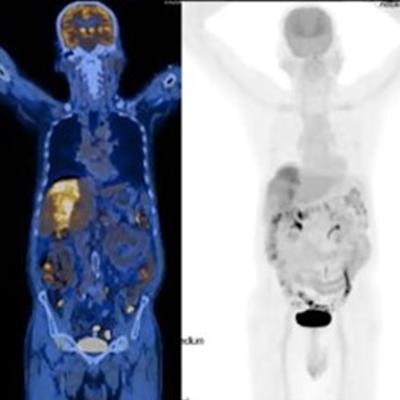
PET/CT imaging of hepatocellular carcinoma (HCC) with an experimental gallium-68-based (Ga-68) radiotracer is more effective than with FDG, according to research presented at RSNA 2021 in Chicago.
In a trial launched in 2015, Indian researchers compared the accuracy of PET/CT imaging with a Ga-68-labeled fibroblast activation protein inhibitor (FAPI) versus FDG for detecting primary tumors in a large group of patients with biopsy-confirmed HCC. They found Ga-68 FAPI was more accurate and suggest that the experimental tracer could replace FDG in such cases in the future.
"Ga-68 FAPI-PET assessment for HCC is a useful imaging tool in terms of definitive assessment of malignancy and scores higher than FDG-PET in accuracy for diagnosing HCC," said Dr. Vineel Inampudi, who received the RSNA's Trainee Research Prize for fellows for the work.
HCC is the most common primary liver cancer worldwide, and it is responsible in the U.S. for more than 25,000 deaths per year. And the number of cases is rising. F-18 FDG-PET is the most commonly used nuclear imaging modality in liver cancer and has proven effective in diagnosis, yet FDG shows variable uptake in tumors and has a sensitivity between 50% and 70%, Inampudi said.
Fibroblast activation protein (FAP) is overexpressed in cancerous fibroblasts in tumors, and PET tracers that combine FAP inhibitors (FAPIs) with Ga-68 have demonstrated promising results preclinically for detecting cancer. These tracers are currently being investigated in several clinical studies.
In this study, Inampudi and colleagues enrolled 850 patients diagnosed with HCC on PET/CT and confirmed by biopsy between January 2015 to January 2021 at Health Care Global Enterprises Hospital in Bangalore. Of these, 443 had background cirrhosis, while 407 patients showed no chronic liver disease. All patients underwent both FDG and Ga-68 FAPI scans one day apart, and the researchers compared the SUVmax of both FDG and Ga-68 FAPI in the tumors.
Five hundred and eighty-one patients had lesions larger than 5 cm and 269 had lesions less than 5 cm in size. FDG-PET/CT revealed 781 FDG-avid lesions and 69 lesions with no FDG uptake. Comparatively, all 850 patients who underwent Ga-68 FAPI imaging showed lesion avidity.
| Improved performance from Ga-68 FAPI-PET in HCC | ||
| FDG-PET | Ga-68 FAPI-PET | |
| Mean SUVmax | 4.39 + 2.1 | 12.29 + 6.86 |
| Sensitivity for detecting HCC | 92% | 100% |
The difference between the techniques for mean SUVmax and sensitivity was statistically significant (p < 0.05), according to the researchers.
Using Ga-68 FAPI-PET/CT at their hospital has boosted patient management and led to "a significant improvement in survival rates," Inampudi said.
 Image courtesy of Dr. Vineel Inampudi.
Image courtesy of Dr. Vineel Inampudi.HCC is one of the most common malignancies in India and is found across various age groups, and the core question to answer in every case is whether a suspected mass is benign or malignant, he added. If malignant, the question becomes whether it is in fact hepatocellular carcinoma or another malignancy, such as cholangiocarcinoma, a cancer of the bile ducts.
Apart from a few clinical parameters, imaging forms a major part of the assessment of these malignancies. Moving forward, Inampudi said the study provides evidence for a more accurate method for diagnosing HCC.
"Ga-68 FAPI-PET ... can possibly replace FDG in the future," he concluded.





















